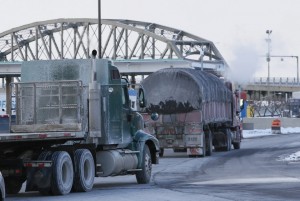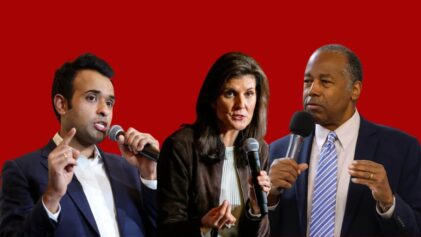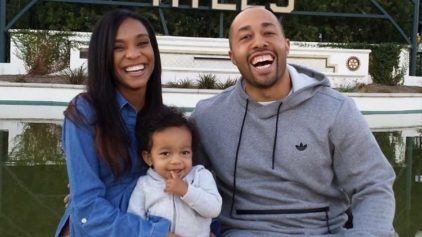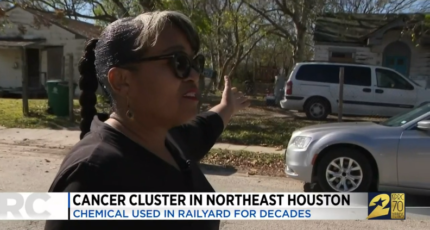
The Peace Bridge is one of the busiest bridges in the country, connecting Fort Erie in Canada to Buffalo, New York, and serving as a major passage for trucks making international deliveries.
Roughly 15,000 vehicles can be spotted driving back and forth across the bridge every day, according to a report by Slate. The massive vehicles pump out extremely harmful diesel emissions and tarnish the air quality of the surrounding area — an area that many low-income and Black families call home.
A small neighborhood called West Side lies close to the busy bridge, putting its residents directly in the path of the harmful side effects that come with poor air quality.
In addition to a variety of reported health issues plaguing the community, Slate reports that the asthma rate is more than four times greater in the small neighborhood than the national average.
One resident even wore an air monitor that was funded through an Environmental Protection Agency grant in order to quantify just how serious the air pollution problem was for the neighborhood.
The device collected “more than 1.8 times the EPA recommended limit of particle pollutants” in the only eight hours that the resident had on the device.
In just that short amount of time, it was clear that something was wrong.
“According to the EPA’s standards, the recommended limit on particle pollutants should not be ‘exceeded more than once per year on average over 3 years,’ ” Slate added.
All of the numbers and stats proved what people within the community knew all along — in America, even the transportation system takes aim at Black people.
It’s a fact that is also a part of American history.
Transportation has long been one of the many industries that discriminates against Black people.
The government has an extensive history of funding massive transportation projects that demolish predominantly Black communities or have segregated street cars, trolleys and buses.
While we are no longer in the days of using separate bathrooms and drinking out of different water fountains, it seems Black communities have gone from sitting in the back of the bus, to barely having a bus to sit on at all.
The government has had no problem funding major bridges and new highways that cater to those who are fortunate enough to have a car. These projects often benefit middle class to upper class white Americans, but very few funds have been dedicated to creating safe and efficient public transit.
Money is being allocated to make transportation more convenient for those who are wealthy while leaving the most vulnerable and less fortunate Americans, often Black people, stranded in their now pollution-filled neighborhoods.
Experts say it’s the difference between blatant racism that forbids Black people from being in the same space as white people and the type of subtle racism that provides Black people with significantly poorer quality of services.
“Discrimination in transportation, quite often it’s more subtle today,” Robert Bullard, dean of Texas Southern University’s school of public affairs, told Slate. “We don’t have laws about posting signs for whites and coloreds. We don’t have laws segregating people on buses and trains … [but] if you look at quality of service, efficiency of service, look at amenities attached to suburban rail versus inner-city bus lines, it’s like night and day.”
It’s the type of stark contrast that has drawn the attention of many advocacy groups, including the Clean Air Coalition of Western New York.
The group filed a Title VI complaint against the currently proposed expansion of the Peace Bridge, a project that would only further degrade the lives of the residents living in communities around the bridge.
A Title VI complaint would strip a project of its federal funding if it is indeed found to be discriminatory based on race, color or national origin, regardless of whether the discrimination was intentional or not.
It is one of the strongest weapons for communities of color trying to fight back against the government-funded projects that are tearing their communities apart — or at least it used to be.
As low-income Black communities were already struggling with the severe lack of efficient bus routes and safe public transportation, the courts eventually took away the best weapon they had to push for equality.
“In 2001, the Supreme Court dramatically changed the way advocates could use Title VI,” Slate reports. “In the case Alexander v. Sandoval, the court altered the standard, concluding that an individual had to prove the policy was intended to cause discrimination, a much higher bar to prove.”
This means it’s no longer enough to prove that the construction of a massive bridge would dump harmful pollutants into a predominantly Black neighborhood. Residents now had to prove the bridge was built with the intention to do so.

It’s a legal move that is making it close to impossible for Black communities to fight back when they find themselves struggling with the impact of discrimination in the transportation sector.
A disproportionately higher number of Black citizens rely on public transportation that is not only present in their neighborhood but also connects them to areas where they may possibly find work or other economic opportunities.
The fact that federal funding seems to be valuing “commuters over community,” as Slate reported, is part of the many ways America’s institutions and policies are trapping Black communities in poverty.
So as these predominantly Black communities are left with massive bridges bringing pollution to their neighborhoods, they are also battling with disparities in health care that are preventing them from getting any real help for these problems. And this is all while they are unable to change their financial situation as they have no way to get to and from the potential jobs that lie just outside the reach of the current, inefficient public transportation systems.


